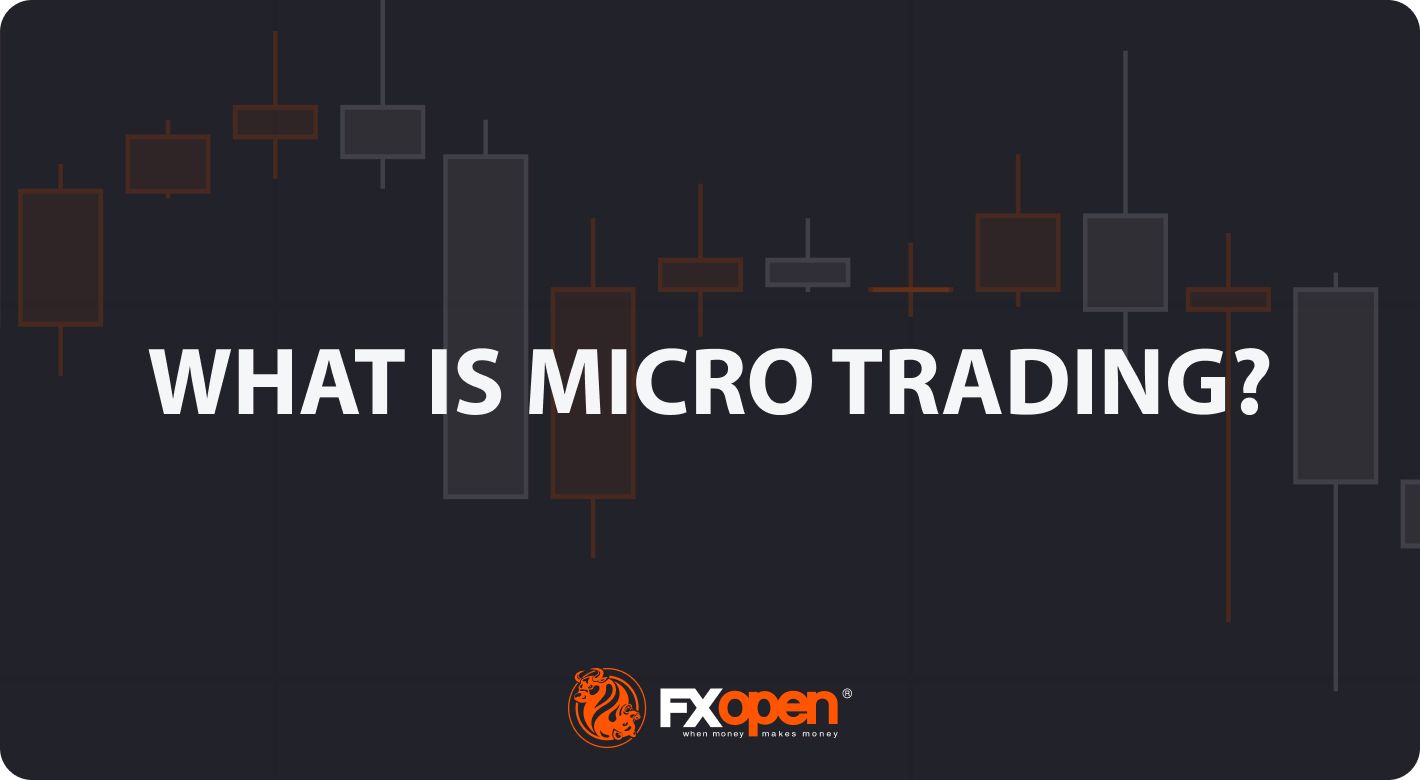FXOpen

Looking to understand "what is scalping in trading?" This FXOpen article clarifies the concept of micro trading, offering a deep understanding of its intricacies and difficulties. By reading this, you'll gain the necessary knowledge to confidently manoeuvre through the dynamic realm of fast-paced trading. Dive in to take your understanding of scaling to the next level.
Understanding Micro Trading
Micro trading, sometimes referred to as scalping, is a style of trading that focuses on capturing small price movements in the market within short time frames, often minutes or even seconds. Unlike day trading, where a trader might hold a position for several hours, or swing trading, where a position could be held for days or weeks, micro traders aim to benefit from tiny, frequent price fluctuations. Trading micro in futures is common, but even more so in spot stock, forex, and commodities markets.
A primary advantage of micro trading is the potential to generate frequent profits due to the high volume of trades. However, it also comes with challenges. The profit margin for each trade is small, so costs and fees can quickly eat into gains. Plus, the rapid pace requires a well-thought-out strategy and discipline to avoid substantial losses.
Order Execution
Order execution refers to the process by which a trade is completed once a trader has submitted an order to buy or sell a financial instrument. In micro trading, rapid execution is paramount due to the short timeframes involved. There are two main components:
- Speed: Delays can drastically affect profitability in micro trading. Reliable platforms and brokers prioritise quick order execution, ensuring minimal lag between order placement and its fulfilment.
- Precision: It's crucial that orders are executed at the desired price levels. Slippage – a difference between the expected price of a trade and the price at which it's executed – can erode potential profits, especially when dealing with small price movements characteristic of micro trading.
Spreads in Scalping vs Normal Trading Strategy
In scalping, spreads play a crucial role due to the thin profit margins on each trade. A spread, the difference between the buy and sell price, can significantly affect a scalper's profitability. Compared to a normal trading strategy, where traders can absorb higher spreads over longer trade durations, scalpers need tight spreads to ensure profitability. Thus, scalpers often gravitate towards assets or markets with narrow spreads and high liquidity, optimising their chances of successful, frequent trades.
Frequency and Costs
In micro trading, the frequency of trades is substantially higher compared to traditional strategies. While this means more opportunities for profit, it also translates to increased transaction costs. Every trade incurs fees, such as commission or platform fees.
The cumulative effect of these costs becomes substantial in micro trading due to the sheer volume of trades executed. Therefore, while the potential for frequent gains is enticing, traders must remain acutely aware of the associated costs. Choosing brokers with competitive rates and understanding fee structures are essential steps in optimising micro trading profitability.
Scalping as a Trading Strategy
Scalping, when adopted as a primary trading style, demands undivided attention, quick reflexes, and a rigorous approach. However, this intense approach might not be suitable for every trader, given its demands on time and emotional resilience.
On the other hand, when used as a supplementary style, scalping can complement other longer-term strategies by providing additional, quick profit opportunities while diversifying trading activities.
Choosing a Scalping Trading Platform
For traders focused on micro trading or scalping, selecting the right platform can significantly impact their success. Several criteria define an optimal scalping platform:
- Fast Execution: In scalping, seconds matter. A platform's ability to quickly execute trades can mean the difference between profit and loss.
- Competitive Pricing: Given the tight profit margins in scalping, low spreads and minimal commissions are crucial.
- Reliability: Downtimes or lags, especially during volatile market conditions, can hinder a scalper's strategy.
- Interface Usability: A user-friendly interface that offers intuitive access to tools and charts can streamline the trading process.
- Advanced Charting and Tools: Real-time data and sophisticated analytical tools help scalpers make informed decisions quickly.
- Regulation: A regulated platform ensures trader security and trustworthiness.
Why Choose FXOpen As Your Preferred Micro Trading App?
When choosing a platform for micro trading, FXOpen emerges as a compelling choice. Regulated by authorities, we offer a secure trading environment. With the renowned MetaTrader 4 (MT4), MetaTrader 5 (MT5), and advanced TickTrader platforms, traders with any level of experience can navigate the markets with confidence.
Our distinction as an ECN/STP broker guarantees the best possible trading conditions and transparency. Moreover, FXOpen’s competitive pricing, with spreads from 0.0 pips and commissions starting at $1.50 per lot, makes it an ideal choice for scalpers. Finally, our range of trading instruments and responsive customer support means you’re always equipped with the necessary tools and assistance to find your edge in the markets.
The Bottom Line
In essence, micro trading or scalping offers a dynamic approach to the markets, capitalising on small price fluctuations. While it promises frequent profits, success hinges on precise execution, discipline, and the right platform. Knowledge and the right tools may increase the chances of a scalper’s success in the trading landscape. You can open an FXOpen account to get started on your micro trading journey today. Good luck!
This article represents the opinion of the Companies operating under the FXOpen brand only. It is not to be construed as an offer, solicitation, or recommendation with respect to products and services provided by the Companies operating under the FXOpen brand, nor is it to be considered financial advice.
Stay ahead of the market!
Subscribe now to our mailing list and receive the latest market news and insights delivered directly to your inbox.








